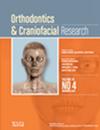Feasibility of spheno-occipital synchondrosis fusion stages as an indicator for the assessment of maxillomandibular growth: A mixed longitudinal study
Abstract
Objectives
This study aimed to assess the relative growth rates (RGRs) of the maxilla and mandible at varying fusion stages of the spheno-occipital synchondrosis (SOS), thereby elucidating the potential of SOS stages in predicting maxillomandibular growth.
Materials and Methods
A total of 320 subjects (171 boys and 149 girls), aged 6 to 18 years, were retrospectively included. Each subject had a minimum of two longitudinal cone-beam computed tomography (CBCT) images, with no more than one interval of SOS fusion stage change between the two scans. Subjects were categorized based on their SOS fusion stages and genders. The RGRs of the maxilla and mandible at various SOS fusion stages were measured and compared using longitudinal CBCT images.
Results
Significant statistical differences were observed in maxillomandibular RGRs across various SOS fusion stages. In girls, the sagittal growth of the maxilla remained stable and active until SOS 3, subsequently exhibited deceleration in SOS 4–5 (compared to SOS 3–4, P < .05) and continued to decrease in SOS 5–6. Whereas in boys, the sagittal growth of the maxilla remained stable until SOS 4, and a deceleration trend emerged starting from SOS 5 to 6 (P < .01 compared to SOS 4–5). Mandibular growth patterns in both genders exhibited a progression of increasing-accelerating-decelerating rates from SOS 2 to 6. The highest RGRs for total mandibular length were observed in SOS 3–4 and SOS 4–5.
Conclusion
Spheno-occipital synchondrosis fusion stages can serve as a valid indicator of maxillomandibular growth maturation.

 求助内容:
求助内容: 应助结果提醒方式:
应助结果提醒方式:


